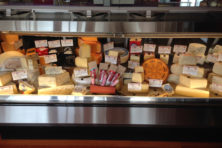The Cheese Insider
- Share
- Tweet
- Pin
- Share
In 2011 the world cheese production was 44.25 billion pounds, yes billion. The United States leads the world with 10.6 billion pounds, followed by Germany, 4.6, France 4.2, Italy with 2.5, and Netherlands with 1.6 billion pounds.
As far as U.S. production Wisconsin leads the way with over 2.7 billion pounds, followed by California, Idaho, New York and New Mexico. Most people would have guessed Wisconsin and California as the leaders in production, but not many people would know that Idaho and New Mexico would be in the top five. Some of the largest commodity cheese plants in the nation are located in those two western states. As a point of reference commodity cheese means mass-produced cheese made in computer driven vats, not specialty cheeses made by hand. Can you say; sliced American singles?
Of the varieties of cheeses produced in the United States mozzarella leads the way with 33 percent of total production, followed closely by cheddar at 29 percent. The majority of the mozzarella produced in the U.S. is made in Wisconsin, and is driven by America’s love for pizza.
The beginnings of cheesemaking are believed to have begun several thousand years ago. The story goes like this; a travelling Arab merchant had stored some fresh camel milk in a saddlebag pouch made from a sheep stomach. Over time the milk transformed into a slightly pale liquid with solid white, pasty chunks. The liquid is what we now call whey, and the pasty chunks are curds.
The Asian travelers and merchants brought the art of cheesemaking to central Europe. The Romans brought the art to England. During the Middle Ages, monks improved the technology of cheesemaking in monasteries across Europe. Gorgonzola was created in Italy in 879 A.D., and Roquefort in France in 1070 A.D. Cheese came to America on the Mayflower along with the Pilgrims in 1620.
The Roman Empire was very influential in early cheesemaking history. Italy is the home for a variety of cheeses: Parmesan, Romano, Asiago, Mozzarella ,Gorgonzola, Fontina, and Taleggio.
France is also known for being a leader in the early days of cheesemaking. Muenster is thought to have originated in Alsace by Irish monks that settled there in the seventh century. Brie and Camembert date back to the eleventh century.
England discovered cheese when the Romans brought it there in the early eleventh century. Cheddar was named for a village in Somersetshire and was brought to America with the early settlers. The English are still known for making some of the finest cheddars, although now some of the very best cheddars are made here in America, especially in Wisconsin.
As the immigrants from Europe arrived in the new world they brought with them the cheeses from their homeland. The Swiss, German, Italians, Dutch and British all had special cheeses, and it wasn’t long before the American cheese industry was born.
Learning the history of cheese is fascinating, eating good cheese is even better.
Michael C. Thomas is co-owner of Schoolhouse Artisan Cheese with his wife Janice. With locations in Ellison Bay and Egg Harbor, they aim to bring the best of Wisconsin artisan cheeses to Door County, and with “The Cheese Insider” Michael hopes to bring all things cheese to readers of the Pulse.




